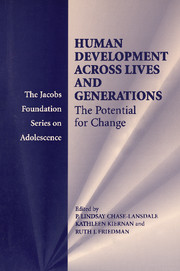Book contents
- Frontmatter
- Contents
- Figures and Tables page
- Contributors
- Foreword
- Acknowledgments
- HUMAN DEVELOPMENT ACROSS LIVES AND GENERATIONS
- Part I Introduction and Overview
- Part II Human Capital
- Part III Partnership Behavior
- 6 Cohabitation and Divorce across Nations and Generations
- 7 The Intergenerational Transmission of Couplelnstability
- 8 Strengthening Partnerships and Families
- Part IV Psychological Health and Development
- Part V Conclusion
- Index
8 - Strengthening Partnerships and Families
from Part III - Partnership Behavior
Published online by Cambridge University Press: 12 October 2018
- Frontmatter
- Contents
- Figures and Tables page
- Contributors
- Foreword
- Acknowledgments
- HUMAN DEVELOPMENT ACROSS LIVES AND GENERATIONS
- Part I Introduction and Overview
- Part II Human Capital
- Part III Partnership Behavior
- 6 Cohabitation and Divorce across Nations and Generations
- 7 The Intergenerational Transmission of Couplelnstability
- 8 Strengthening Partnerships and Families
- Part IV Psychological Health and Development
- Part V Conclusion
- Index
Summary
“Marriage is one of the most nearly universal of human institutions. No other touches so intimately the life of practically every member of the earth's population” (Terman, 1938, p. 1). Terman's introductory lines (written in 1938) are still characterizing the Status of marriage today. Across almost all countries and cultures most people are involved in intimate couple relationships at some point in their lives, may it be marriage or cohabitation (Buss, 1995). Since 1970, marriage rates are declining in most western countries, the average age at marriage is increasing, and the rate of cohabitation is growing. However, marriage remains the most populär means of expressing commitment in a couple relationship. Based on data from the 90s, within five years of cohabitation between 50% to 66% of couples in most European countries (US: 82%) had married (with the exception of Sweden: 33%), while between 25% and 33% had dissolved their relationship (US: 47%; see Kiernan, this volume). At least until the 90s, by the age of 50 about 90% of the population in western countries is or was married at least once (McDonald, 1995).
In this chapter, the determinants of marital distress and the effectiveness of preventive interventions to reduce relationship problems will be summarized with a focus on cognitive-behavioral approaches and findings from longitudinal studies, conducted in the United States and Europe. The various prevention interventions do have the potential to promote the healthy development of our nations. However, concentrated, nationwide efforts are necessary to change the current trend of deteriorating families.
Relationship Satisfaction
There is no agreed upon definition for a satisfying relationship. However, most researchers believe “that relationship satisfaction can be defined as an individual partner's global sentiment about, or evaluation of, their relationship. An advantage of this construct is that it does not define an ideal relationship, but rather asks partners to rate the extent to which their relationship satisfies their individual expectations” (Haiford, 2000, p. 13).
In research, relationship satisfaction (or quality or adjustment)is usually measured in the form of the score on a standardardized self-report measure. Examples are the Locke-Wallace Marital Adjustment Test MAT (Locke & Wallace, 1959), the Dyadic Adjustment Scale DAS (Spanier, 1976), or the Partnerschaftsfragebogen PFB (Partnership Questionnaire, Hahlweg, 1996).
- Type
- Chapter
- Information
- Human Development across Lives and GenerationsThe Potential for Change, pp. 204 - 236Publisher: Cambridge University PressPrint publication year: 2004
- 2
- Cited by

